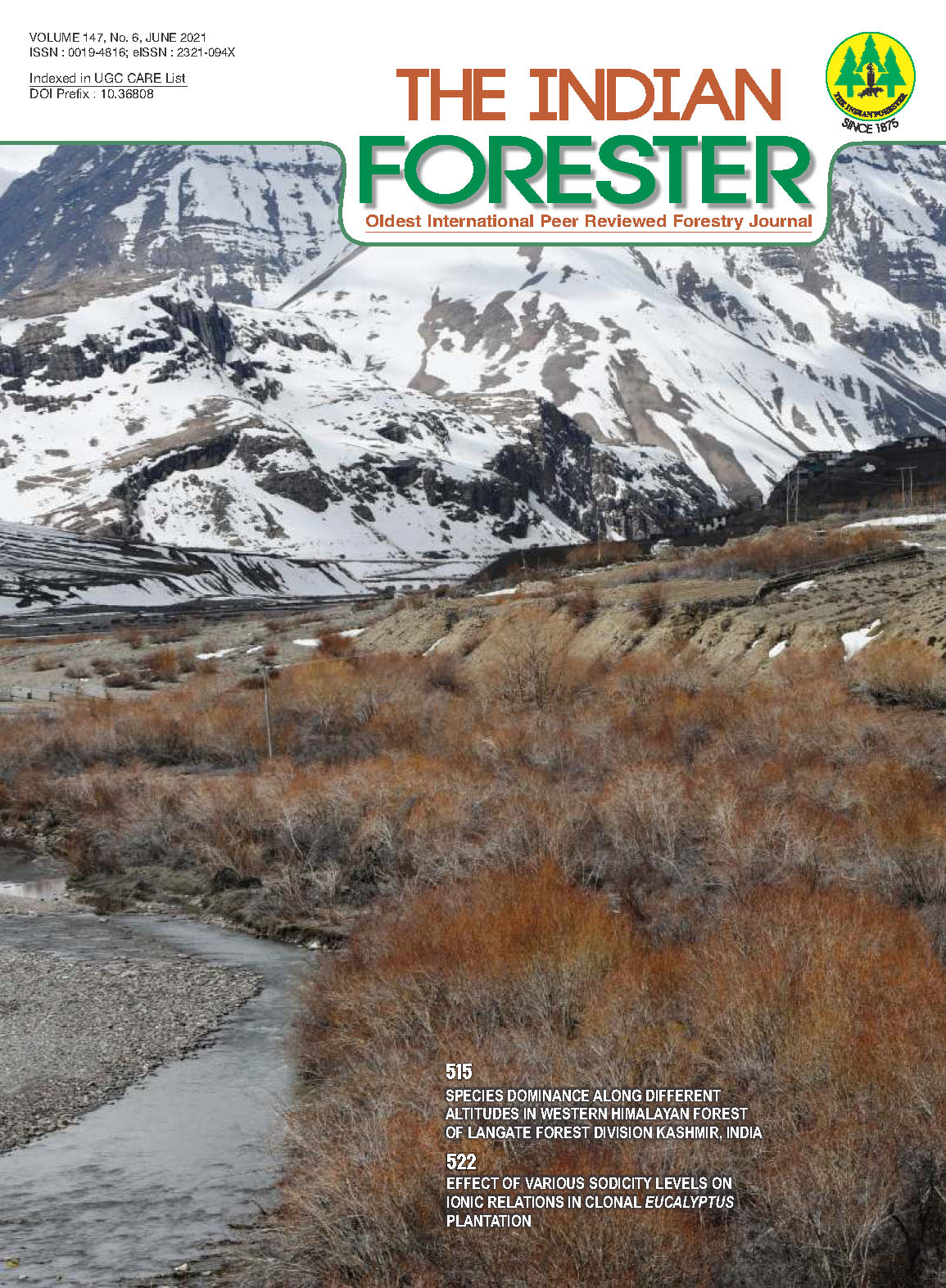Species Dominance along Different Altitudes in Western Himalayan Forest of Langate Forest Division Kashmir, India
DOI:
https://doi.org/10.36808/if/2021/v147i6/154797Keywords:
Floristic Diversity, Phytosociology, IVI, Basal Area.Abstract
Due to biotic and abiotic factors, there is a continuous loss in floristic diversity and changing patterns of vegetation which have necessitated the qualitative and quantitative assessment of vegetation. This study aims at a floristic assessment of trees, shrubs, and herbaceous species at different altitudinal gradients (1500-2000, 2000-2500, 2500-3000m) for which the quadrate method was adopted. Altogether 44 plant species belonging to 16 families were found present in the study region. The results revealed that all altitudinal gradients (1500-2000m, 2000-2500m, 2500-3000m) varied in the dominance of species. Pinus wallichiana, Indigofera heterantha and Cynodon dactylon, in the lower altitudinal gradient (1500-2000m) and Pinus wallichiana, Cotoneaster falconeri and Dactylis glomerata were found dominant in the middle altitudinal gradient (2000-2500m) whereas Abies pindrow, Skimmia laureola and Poa pratensis was found as the principal association on the upper altitude (2500-3000m).References
Anitha K., Joseph S., John C.R., Ramasamy E.V. and Prasad S.N. (2010). Tree species diversity and community composition in a human-dominated tropical forest of Western Ghats biodiversity hotspot, India. Ecological Complexity, 7: 217–224.
Chawla A., Rajkumar S., Singh K. N., Lal B., Singh R.D. and Thukral A.K. (2008). Plant species diversity along an altitudinal gradient of Bhabha Valley in western Himalaya. Journal of Mountain Science, 5(2): 157-177.
Curtis J.T. and McIntosh R.P. (1950). The interrelations of certain analytic and synthetic phytosociological characters. Ecology, 31: 434-455.
Gairola S., Sharma C.M. and Suyal S. (2011). Species composition and diversity in mid-altitudinal moist temperate forests of the western Himalaya. Journal of Forest Science; 27:1-15.
Gairola S., Rawal R.S. and Todaria N.P. (2015). Effect of anthropogenic disturbance on vegetation characteristics of sub-alpine forests in and around Valley of Flowers National Park, a world heritage site of India. Tropical Ecology, 56(3).
Kala C.P. and Mathur V.B. (2002). Patterns of plant species distribution in the Trans Himalayan region of Ladakh, India. Journal of Vegetation Science, 13(6): 751-754.
Miehe G., Pendry C. and Chaudhary R P. (Eds.). (2015). Nepal: An Introduction to the Natural History, Ecology and Human Environment of the Himalyas: a Companion Volume to the Flora of Nepal. Royal Botanic Garden Edinburgh.
Misra R. (1968). Ecology Workbook. Oxford and IBH Publishing Company, Culcutta.
Oommen M.A. and Shanker K. (2005). Elevational species richness patterns emerge from multiple local mechanisms in Himalayan woody plants. Ecology, 86(11): 3039-3047.
Rezende L., de Miranda S., Meyer L., Linhares M. Filho T. and Eisenlohr P. (2015). Tree species composition and richness along altitudinal gradients as a tool for conservation decisions: the case of Atlantic semideciduous forest. Biodivers Conserv., 24: 2149–2163
Shaheen H., Aziz S. and Dar M.E.U.I. (2017). Ecosystem services and structure of western Himalayan temperate forests stands in Neelum valley, Pakistan. Pakistan Journal of Botany, 49(2): 707-714.
Sharma C.M., Ghildiyal S.K., Gairola S. and Suyal S. (2009). Vegetation structure, composition and diversity in relation to the soil characteristics of temperate mixed broad-leaved forest along an altitudinal gradient in Garhwal Himalaya. Indian Journal of Science and Technology, 2(7): 39-45.
Sharma E., Chettri N. and Oli K.P. (2010). Mountain biodiversity conservation and management: A paradigm shift in policies and practices in the Hindu Kush-Himalayas. Ecological Research, 25(5): 909–923.
Uma Shankar (2001). A case of high tree diversity in a Sal (Shorea robusta) - dominated lowland forest of Eastern Himalaya: Floristic composition, regeneration and conservation. Current Science, 81: 776-786.
Zomer R. J., Wang M., Trabucco A. and Xu J. (2016). Projected climate change impact on hydrology, bioclimatic conditions and terrestrial ecosystems in the Asian highlands. ICRAF Working Paper-World Agroforestry Centre, (222).
Downloads
Downloads
Published
How to Cite
Issue
Section
License
Unless otherwise stated, copyright or similar rights in all materials presented on the site, including graphical images, are owned by Indian Forester.





